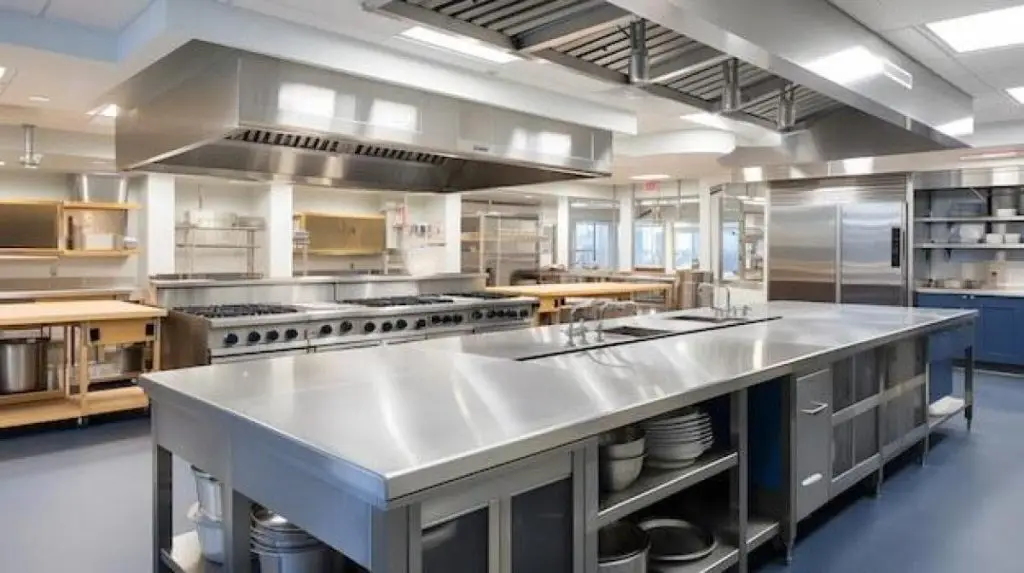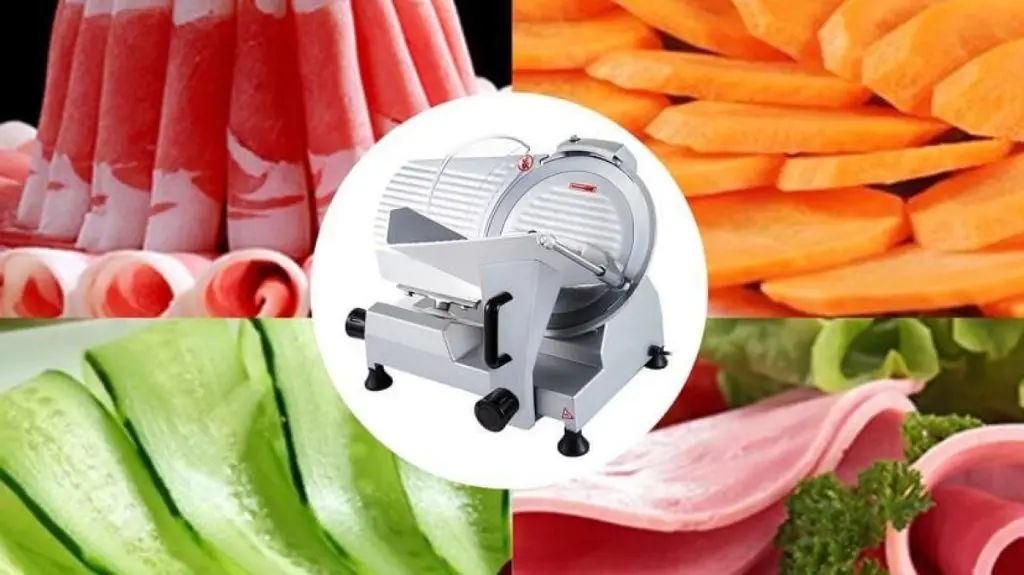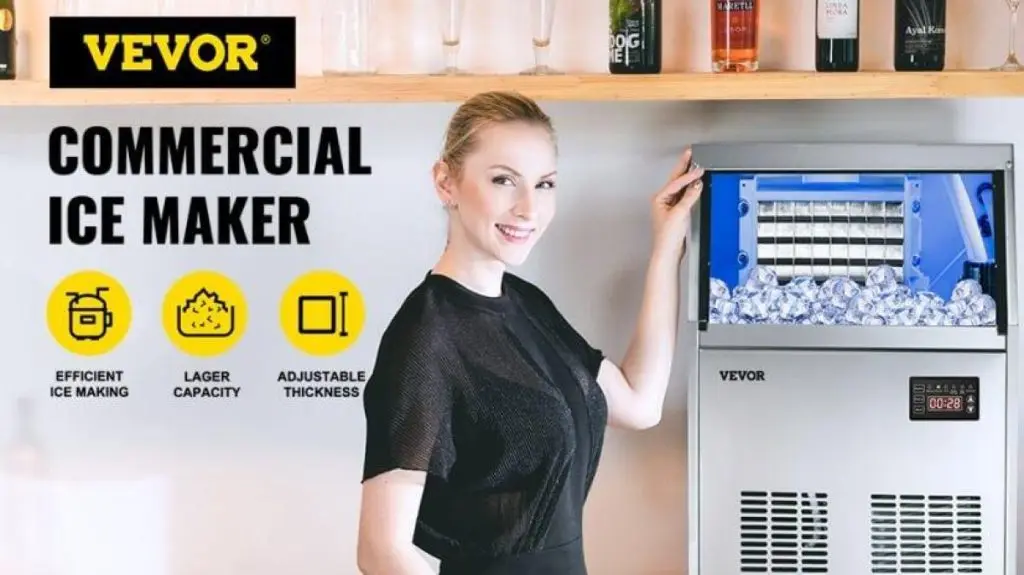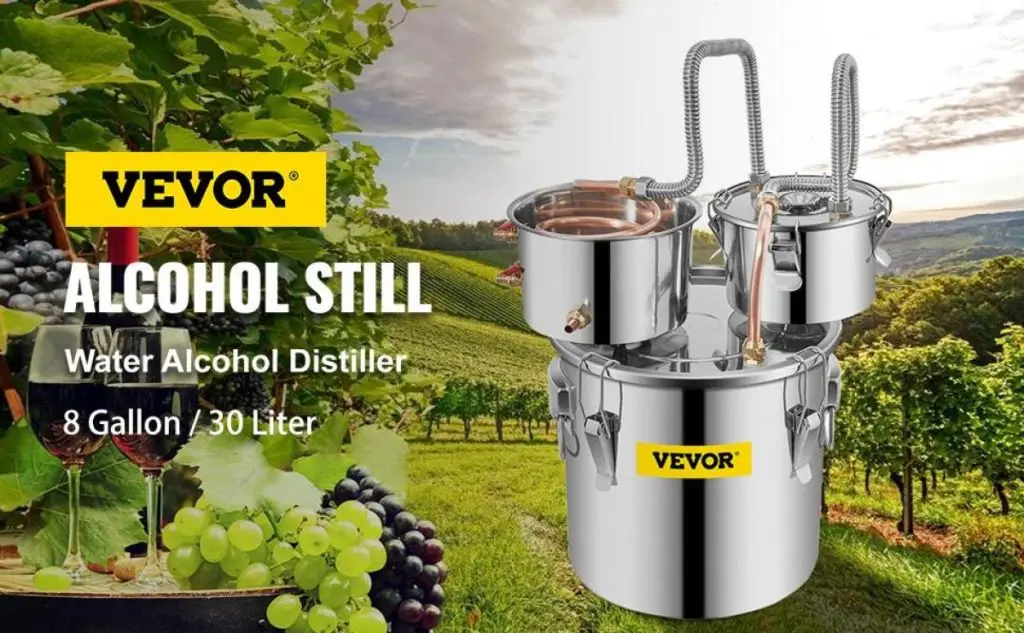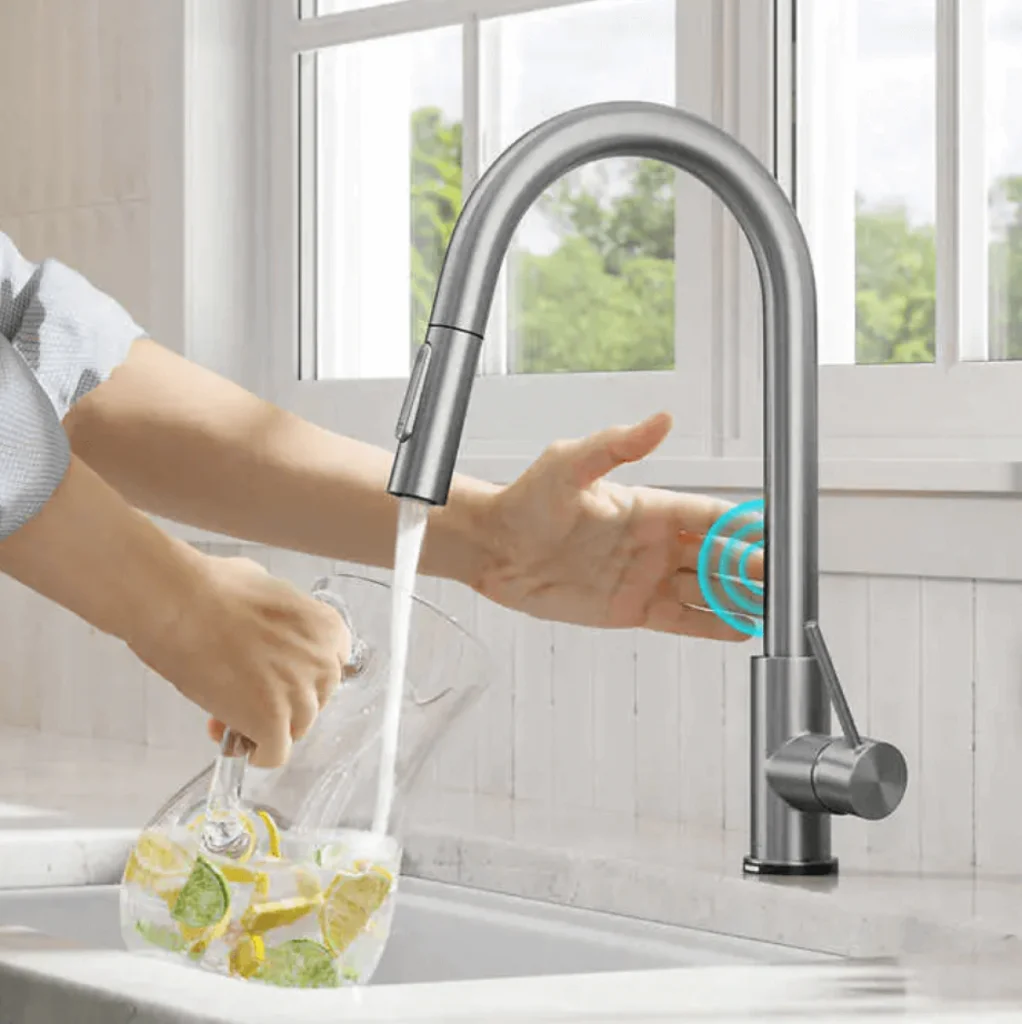Notorious bacteria, causing foodborne illnesses, love to breed in nooks and crannies of commercial kitchens, rendering proper commercial kitchen cleaning an absolute necessity.
Commercial kitchen cleaning goes far beyond surface-level tidying because unseen dangers continue to lurk beneath gleaming surfaces unless cleaned properly.
In a busy commercial kitchen, pathogens can lurk in many places—from kitchen appliances such as deep fryers, ovens, meat grinders, and slicers to kitchen surfaces such as countertops, cutting boards, floors, dining surfaces, etc., and storage areas such as refrigerators and freezers, cabinets and pantries, etc.
An unclean commercial kitchen can become a breeding ground for pathogens, causing foodborne illnesses for your patron and staff, which is bad for business.
So, if you do not want your patrons and staff to get foodborne illnesses, continue reading. In this comprehensive guide, “How to Clean a Commercial Kitchen? An In-Depth Guide,” we discussed commercial kitchen cleaning. We’ve covered everything from essential supplies for commercial kitchen deep cleaning to techniques and procedures for cleaning commercial kitchen appliances, surfaces, and storage areas.
So, let’s get started!
The Supplies You’ll Need For Cleaning a Commercial Kitchen
Properly cleaning a commercial kitchen may seem impossible, but with the right supplies and cleaning guidelines, it can become manageable. Here are supplies that you will need for effectively cleaning a commercial kitchen:
- Degreaser: Heavy-duty degreasers can help eliminate stubborn grease build-up on cooking surfaces, hoods, and ventilation systems. Look for commercial-grade degreasers designed specifically for kitchen use to ensure the effective breakdown of stubborn deposits.
- Disinfectant: Disinfectants kill bacteria. Food service establishments need a reliable food-grade disinfectant to eliminate bacteria and other harmful pathogens from their food preparation areas.
- Cleaning Cloths and Scrubbing Pads: Microfiber cleaning cloths are excellent for general cleaning tasks. However, you will need sturdy scouring pads to deal with stubborn stains and grime. Consider color-coded cloths to reduce the risk of cross-contamination.
- Floor Cleaning Supplies: You will need an appropriate mop and bucket with a cleaning solution for commercial kitchen floors. Consider non-slip mop heads to ensure safety and two bucket systems to prevent cross-contamination.
- Gloves: Commercial kitchen cleaning will involve the use of harsh chemicals and hot water. Therefore, you must wear protective gloves to ensure your safety. Similarly, while cleaning commercial kitchen appliances with sharp blades, you must wear cut-resistant gloves to protect your hands.
- Broom, Dustpan, and Brushes: Brooms and dustpans are essential tools for removing debris before mopping. And for reaching hard-to-reach corners and crevices, you will need specialized brushes.
- Trash Bags and Waste Disposal System: Leak-proof trash bags designed with heavy-duty material are a necessity for the safe and efficient disposal of food waste. A properly functioning waste disposal system is also crucial for deterring pest infestation.
- Personal Protective Equipment (PPE): Safety goggles and face masks provide essential eye and respiratory protection from cleaning chemicals and airborne pollutants when deep cleaning restaurant kitchens.
- Deep clean commercial kitchen checklist: Commercial kitchen cleaning is not an easy task, and without a comprehensive and exhaustive deep clean commercial kitchen checklist, the staff might miss a few spots and things to clean and sanitize, leaving room for pathogens to grow.
Commercial Kitchen Equipment Cleaning
Appliances and equipment are pivotal in any commercial kitchen in driving culinary excellence. At the same time, these items also increase the risk of foodborne illnesses when not cleaned properly. Here is a detailed guide on how to clean commercial kitchen equipment:
Cleaning Commercial Deep Fryer
Begin by unplugging and draining out all oil residue from the fryer basket. Next, wipe down the exterior, clean the fryer basket and heating elements, and boil out the fryer at the end.
Check our detailed guide: How to Clean a Commercial Deep Fryer? The Ultimate Guide!
Grills and Griddles
For thoroughly cleaning commercial kitchen griddles and grills, heat the surface and scrape away debris. Next, scrub it with a grill stone or baking soda mixture. For scrubbing griddles, use a degreaser. Once scrubbed, rinse it thoroughly with warm water and wipe it dry.
Ovens
The process of commercial oven cleaning begins with the removal of grates and racks from the oven. Once removed, you soak them in warm, soapy water for a while and then scrub off any persistent burnt bits. Next, wipe the interior and exterior of the oven using a wet rag, and if need be, use an oven cleaner.
Meat Slicers and Grinders
Regularly cleaning meat grinders and slicers is imperative to prevent pathogen growth that may cause foodborne illnesses. To clean meat slicers and grinders, you should disassemble them. Soak each part in warm, soapy water or a degreaser spray. Next, dry the components and apply a food-grade sanitizer. Before reassembling, ensure that all parts are completely dry.
Dishwashers
Begin by clearing away food particles from filters, cleaning racks, and spraying arms with a soft brush or cloth. Next, run the dishwasher cycle with either commercial dishwasher cleaners or just a vinegar-baking soda mixture. After that, wipe down the exterior, control panel, and handles with a food-grade sanitizer.
Coffee Makers
Coffee maker cleaning requires descaling with a solution of equal parts water and vinegar. Run a brewing cycle without coffee grounds, then run a few cycles with warm water to eliminate the vinegar taste. You should also detach all removable parts and clean them with warm, soapy water for proper cleaning. Finally, you should wipe the exterior with a sanitizing solution and ensure all parts are dry before reassembling.
Ice Machines
For sanitizing and cleaning ice machines, follow the manufacturer’s instructions. Typically, this will involve emptying out and cleaning the bin, disinfecting internal components, and running a cleaning solution through the machine.
Regular restaurant equipment cleaning helps you maintain an immaculate appearance, keeps foodborne illnesses at bay, and prolongs appliances’ lifespan.
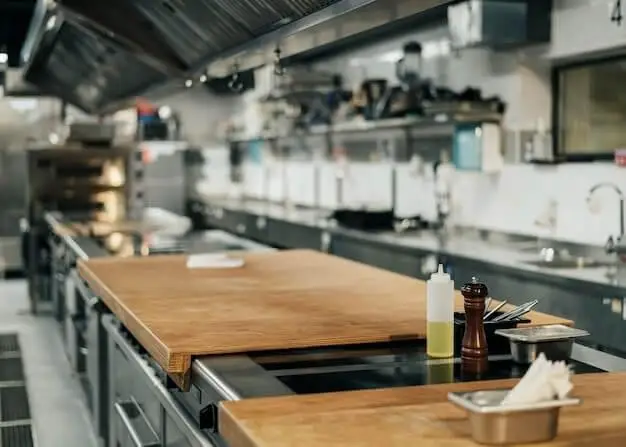
Cleaning the Kitchen Surfaces
Immaculately cleaning commercial kitchen surfaces is not only necessary for upholding the professional image of your food establishment but also for ensuring food safety and maintaining the delectable taste of your dishes.
Countertops
Begin by clearing all items off the countertops and wiping them with a mild detergent or an all-purpose cleaner. Ensure that you reach all corners and edges. And once it’s dry, disinfect using food-grade sanitizer.
Cutting Boards
You can clean your plastic cutting boards with a dishwasher on a hot water cycle. But when it needs to be done manually, or you have a wooden board, scrub it with hot, soapy water using a scrub brush.
Stainless Steel Surfaces
Stainless steel surfaces can become susceptible to fingerprints and smudges over time. To maintain them in their best condition, use a microfiber cloth with stainless steel cleaner for effective cleaning and polishing. Avoid harsh cleaners to avoid scratches.
Tile Walls and Backsplashes
Utilize a tile cleaner containing equal parts water and vinegar for regular cleaning of tile walls and backsplashes. When dealing with mold or mildew in grout lines, use an old toothbrush with soapy water to scrub along the length of grout lines.
Sinks
Clean sinks daily using a mild abrasive cleaner to eliminate stains, and don’t forget the faucet handles or area surrounding your sink. When handling raw meat in the sink, do not forget to promptly disinfect it with a bleach solution before using the sink again.
Windows and Glass Surfaces
Use a glass cleaner to clean windows and other glass surfaces. Pay special attention to entry doors and customer-facing windows.
Floors
Remove debris by sweeping the floor first. Then mop it using a hot, soapy water solution or any other floor cleaner. Next, mop the floor with plain hot water to remove excess soap or cleaning agents.
Dining Surfaces
If your establishment features dining tables, ensure they are regularly cleaned and sanitized between customers using food-grade sanitizer.
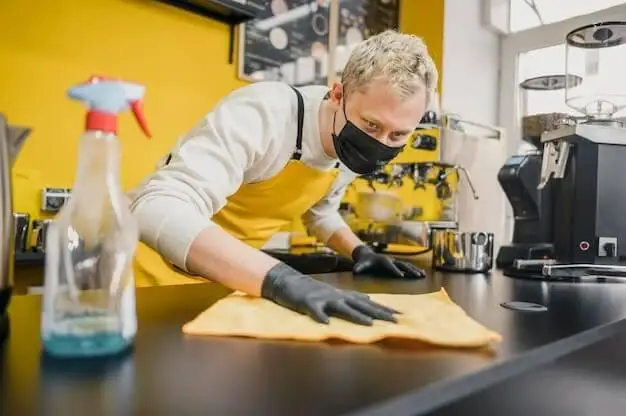
Cleaning Storage Areas
Without proper cleaning, storage areas can become breeding grounds for contamination and spoilage, spreading foodborne illnesses among your patrons and staff and ruining your food business.
Refrigerators and Freezers
Cleaning commercial refrigerators and freezers is simple. Unplug it, remove all items from shelves, and get rid of expired items. Next, wipe off, disinfect the interior and exterior, and restock all food items—all done!
If applicable, defrost your freezer according to its manufacturer’s instructions before cleaning its interior once defrosted.
Dry Storage Areas
Start by emptying and cleaning shelves with a damp cloth. Next, check if there is any pest activity; if necessary, take appropriate pest control measures. Sanitize the interior of the storage area with a food-grade sanitizing solution. Before restocking, get rid of expired or spoiled items and use an inventory first-in, first-out (FIFO) system to minimize spoilage risk.
Waste Disposal Areas
Bins should be regularly emptied to prevent overflow, foul odors, and overspill of garbage. Also, regularly wash trash and recycling bins using hot, soapy water while disinfecting them to reduce bacterial growth in these spaces. Do not forget to clean and disinfect areas surrounding waste bins.
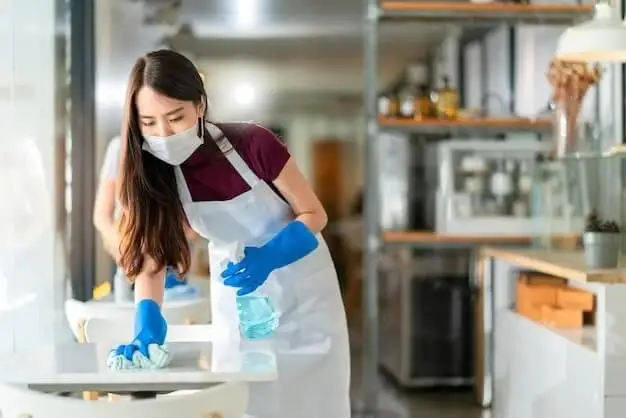
Cleaning the Commercial Kitchen Structures
Neglecting commercial kitchen structures such as exhaust systems, ventilation systems, and surfaces could result in both hygiene issues as well as potential fire risks. Therefore, regular and thorough cleaning of these structural elements is vital.
Exhaust Hoods
To clean exhaust hoods, remove and soak filters, then scrub and rinse them. Next, wipe the interior and exterior of the hood with a degreasing solution. Also, do not forget to clean the exhaust fans and unplug them before cleaning.
Ventilation and Air Circulation
Wipe down vent covers regularly to remove dust and grease build-up for better airflow. Also, check the air ducts before cleaning them to ensure no blockage. As far as the air filters are concerned, change and clean them regularly according to the recommendation for removing contaminants.
Ceilings and Walls
Replace or clean ceiling tiles regularly in areas subject to grease or steam build-up by using water and baking soda paste or white vinegar mixed with water. Similarly, clean painted walls with warm, soapy water, and you can use baking soda paste for stubborn stains. For easier cleaning, use satin or semi-gloss paint in your kitchens.
Floor Drains
Besides sweeping and mopping floors regularly, you will also need to pay close attention to floor drains. Ensure that there is no blockage. You should run hot water through it to dissolve and clean the grease clogging the drain. If need be, you can use a plunger or a plunging snake to remove blockage. Besides ensuring that the drain is properly running, you must disinfect it regularly to eliminate pest breeding grounds.

Commercial Kitchen Cleaning and Maintenance Routine
Maintaining an immaculate commercial kitchen requires more than occasional cleaning; it requires an organized approach—a routine.
Daily Commercial Kitchen Cleaning Routine
You need to focus on high-touch surfaces and high-traffic areas in your daily cleaning routine. Here is what must be included in your daily commercial kitchen cleaning routine.
- Food Preparation Areas: You must thoroughly clean and sanitize food preparation areas after each use to prevent cross-contamination. This will include all surfaces and areas where the food is handled, such as countertops, cutting boards, prep tables, sinks, etc. Besides, after each use, you should also clean and disinfect these areas after shift change and at day end.
- Appliance Cleaning: Different kitchen appliances have different levels and frequencies of cleaning requirements. You must check the manufacturer’s and FDA guidelines on the cleaning frequency of your commercial kitchen appliances. For instance, meat grinders and meat slicers need to be cleaned every four hours.
- Dishwashing Area: To ensure an efficient dishwashing area, regularly sanitize sinks, dish racks, and dishwashing tools. Also, regularly replace or sanitize the dishcloths and sponges in your commercial kitchen.
- Floor Maintenance: Sweep and mop the kitchen floor carefully, paying special attention to corners and under equipment. Clean any spills immediately to avoid slips and falls.
- Trash Disposal: Empty all trash bins as soon as they become full and sanitize them to prevent foul odors or pest problems from developing in them.
Weekly Commercial Kitchen Cleaning Routine
To ensure the immaculate cleanliness of your commercial kitchen, besides daily cleaning, you will also need a weekly commercial kitchen deep cleaning routine. In your weekly cleaning routine, you will have to ensure that you get all those hidden and hard-to-reach nooks and crannies in your commercial kitchen to deny any haven to pathogens.
- Deep Appliance Cleaning: Disassemble appliances like grills, griddles, and ovens in your commercial kitchen according to the manufacturer’s instructions.
- Ventilation Systems: Inspect and clean exhaust hoods, ducts, and fans as necessary before scheduling professional exhaust system cleaning if required.
- Floor Detailing: For optimal kitchen floor care, scrub with a degreaser to remove stubborn stains and grease build-up. In the weekly floor cleaning routine, pay close attention to hidden and hard-to-reach areas and grout lines.
- Descaling Washers and Sinks: Descale dishwashers and glassware washers biweekly or weekly, depending on the usage level. You should also descale taps and sinks.
- Descaling Boilers And Small Appliances: To ensure optimal performance and hygiene, you should descale your coffee machines, toasters, kettle, and water boilers regularly to ensure optimal performance.
- Inspection: Besides cleaning, it is also a good idea to thoroughly inspect your entire kitchen with a focus on hard-to-reach areas to check if anything needs repair or maintenance.

Monthly Commercial Kitchen Cleaning Routine
Similar to weekly cleaning, there are kitchen areas and equipment that need cleaning every month. Monthly cleaning will be more thorough, requiring a longer time. Therefore, you must plan monthly kitchen cleanings ahead of time.
- Storage Areas: Empty cabinets, pantries, and all other storage areas, and clean and sanitize the shelves. Before restocking, ensure that there is nothing expired, damaged, or spoiled. Look for signs of pests and, if necessary, take pest control measures.
- Refrigerators and Freezers: You should also empty refrigerators and freezers in your commercial kitchen. Wipe and clean their interiors and sanitize them properly. You should also get rid of spoiled and expired items.
- Appliance Maintenance: Inspect your kitchen appliances for wear and tear and promptly repair or replace damaged parts to ensure optimal functioning and prevent potential hazards.
- Cleaning Behind Equipment: Besides cleaning everything right in front of you, it is also a good idea to clean behind the equipment placed against the walls. This generally involves cleaning behind ovens, stoves, fryers, and shelves, etc.
Quarterly and Annual Commercial Kitchen Cleaning Routine
While a monthly cleaning routine is deemed sufficient by many food establishments, it is also a good idea to have a comprehensive quarterly or annual routine.
- Deep Structural Cleaning: Conduct a deep structural cleaning of walls, ceilings, and floor drains, as well as inspect grout lines and seams for signs of dirt accumulation.
- Pest Inspection: Thoroughly inspect your kitchen for pest and rodent droppings. If you find any signs of rodents or pests, you must take necessary preventive measures and consider hiring professional pest control services.
- Inspection of Equipment: Review all your kitchen equipment comprehensively to maintain efficiency and prevent any potential hazards. Replace or repair worn-out parts if necessary to maintain peak performance.
Note: Different kitchens require different cleaning routines, depending on their equipment and activity. So, while you can get help from the above-discussed routines, you must develop your own commercial kitchen deep cleaning routines.
Conclusion
Commercial kitchen cleaning is not an easy endeavor. But with appropriate supplies, comprehensive and exhaustive checklists, and routines, keeping a commercial kitchen immaculate becomes easier. Our comprehensive guide, from essential supplies to strict routines, equips you with everything that you need to uphold impeccable hygiene standards.
Cleanliness in commercial kitchens is crucial for culinary excellence to thrive, ensuring the health and safety of patrons and staff and upholding food establishments’ reputations. Therefore, when equipping your commercial kitchen, consider going for easy-to-clean equipment.
At VEVOR, we understand the need for regular cleaning and sanitizing of kitchen equipment, and thus, we design them while keeping the ease of cleaning and maintenance in mind.

